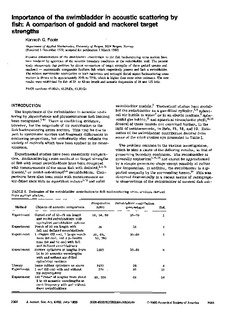| dc.contributor.author | Foote, Kenneth G. | |
| dc.date.accessioned | 2007-07-04T12:48:59Z | |
| dc.date.issued | 1980 | |
| dc.identifier.uri | http://hdl.handle.net/11250/108019 | |
| dc.description | Journal home page: http://scitation.aip.org/jasa/ | |
| dc.description.abstract | Previous determinations of the swimbladder contribution to the fish backscattering cross section have been hindered by ignorance of the acoustic boundary conditions at the swimbladder wall. The present study circumvents this problem by direct comparison of target strengths of three gadoid species and mackerel — anatomically comparable fusiform fish which respectively possess and lack a swimbladder. The relative swimbladder contribution to both maximum and averaged dorsal aspect backscattering cross sections is shown to be approximately 90% to 95%, which is higher than most other estimates. The new results were established for fish of 29- to 42-cm length and acoustic frequencies of 38 and 120 kHz. | en |
| dc.format.extent | 407707 bytes | |
| dc.format.mimetype | application/pdf | |
| dc.language.iso | eng | en |
| dc.subject | acoustics | en |
| dc.subject | swimbladdered fish | en |
| dc.subject | mackerel | en |
| dc.subject | Scomber scombrus | en |
| dc.subject | gadoids | en |
| dc.title | Importance of the swimbladder in acoustic scattering by fish: A comparison of gadoid and mackerel target strengths | en |
| dc.type | Journal article | en |
| dc.type | Peer reviewed | |
| dc.source.pagenumber | 2084-2089 | en |
| dc.source.volume | 67 | en |
| dc.source.journal | The Journal of the Acoustical Society of America | en |
| dc.source.issue | 6 | en |
